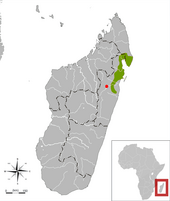Salanoia
| Salanoia | ||||||||||||
|---|---|---|---|---|---|---|---|---|---|---|---|---|

|
||||||||||||
| Systematics | ||||||||||||
|
||||||||||||
| Scientific name | ||||||||||||
| Salanoia | ||||||||||||
| Gray , 1864 |
Salanoia is a genus of the Malagasy carnivores (Eupleridae). It consists of two types of small predators , the sizing mung ( Salanoia concolor ) and the 2010 described salanoia durrelli .
features
The species of the genus Salanoia , like all Madagascar mongooses, have an elongated, slender body with short limbs. The skull is flattened, the muzzle elongated, although this is somewhat blunt in Salanoia durrelli than in the plain mongoose . The fur of both species is dark brown on the upper side ( slightly lighter in Salanoia durrelli ), the belly is reddish brown in the plain mongoose and yellowish brown in color in Salanoia durrelli . In contrast to other Madagascar mongooses, there are no stripes, and the tail is monochrome except for the tip of Salanoia durrelli .
The plain mongoose reaches a head-torso length of 35 to 38 centimeters, Salanoia durrelli is probably somewhat smaller (the two measured individuals had a head-torso length of 31 and 33 centimeters), the bushy tail is 16 to 20 in both species or 21 centimeters long and the weight is 550 to 780 grams (for Salanoia durrelli 600 and 675 grams).
Distribution and way of life
Both species are endemic to Madagascar . The habitat of the mongoose are rainforests in the northeast of the island, for example on the Masoala peninsula . They occur primarily between 300 and 700 meters above sea level, occasionally up to 1000 meters. Salanoia durrelli is only found in the marshland of Lac Alaotra in north-eastern Madagascar.
Little is known about the way of life of both species, especially the Salanoia durrelli , which was first described in 2010 . The diet of the mongoose consists mainly of insects, such as beetle larvae, while the more powerful teeth of Salanoia durrelli indicate hard-shell prey such as crustaceans and molluscs .
Systematics
The genus comprises two species, the sizing mung ( Salanoia concolor ) and the 2010 described salanoia durrelli .
|
Phylogenetic system of the Malagasy carnivores
|
While the genetic findings clearly indicate that the Malagasy carnivores are a monophyletic group, that is, descended from a common ancestor, the internal systematics is more controversial. The Madagascar mongooses probably also form a monophyletic group - although the position of the common mongoose and thus the genus Salanoia is not exactly known. Durbin et al. 2010, based on their investigation, suggest a sister group relationship between the genus Salanoia and the narrow- striped mongoose , with the broad-striped mongoose appearing as the heaviest species.
Danger
Due to the destruction of their habitat, the finishing mongoose is listed by the IUCN as "endangered" ( vulnerable ). There is no evidence of hunting or hunting by introduced species ( neozoa ), but these factors could also pose a threat.
The habitat of Salanoia durrelli is endangered by environmental pollution, habitat destruction for use by rice fields, overfishing and the establishment of introduced species ( neozoa ) such as the black rat ( Rattus rattus ) and the small Indian civet ( Viverricula indica ), a small predator. The Delacour Little Grebe ( Tachybaptus rufolavatus ), a species of bird whose range was limited to this region, was declared extinct in 2010 and the population of bamboo lemurs fell by about 30% within five years until 2001. As a species with a very limited habitat , which is endangered and in competition with several introduced species, the population of this species is also likely to be critically endangered, but has not yet been recorded.
supporting documents
- ↑ a b c Joanna Durbin, Stephan M. Funk, Frank Hawkins, Daphne M. Hills, Paulina D. Jenkins, Clive B. Moncrieff, Fidimalala Bruno Ralainasolo: Investigations into the status of a new taxon of Salanoia (Mammalia: Carnivora: Eupleridae ) from the marshes of Lac Alaotra, Madagascar. Systematics and Biodiversity 8 (3), 2010: pp. 341–355. doi : 10.1080 / 14772001003756751
- ^ Anne D. Yoder, Melissa M. Burns, Sarah Zehr, Thomas Delefosse, Geraldine Veron, Steven M. Goodman and John J. Flynn: Single origin of Malagasy Carnivora from an African ancestor. In: Nature 421 (2003), pp. 734-737. PDF
- ^ BirdLife International: Species factsheet: Tachybaptus rufolavatus. BirdLife International website. Downloaded on August 3, 2010.
literature
- Ronald M. Nowak: Walker's Mammals of the World . Johns Hopkins University Press, Baltimore 1999, ISBN 0-8018-5789-9 .
- Don E. Wilson, Russell A. Mittermeier (Eds.): Handbook of the Mammals of the World. Volume 1: Carnivores. Lynx Edicions, 2009, ISBN 978-84-96553-49-1 .
- Nick Garbutt: Mammals of Madagascar. A Complete Guide. Yale University Press, New Haven & London 2007, ISBN 978-0-300-12550-4
- Joanna Durbin, Stephan M. Funk, Frank Hawkins , Daphne M. Hills, Paulina D. Jenkins, Clive B. Moncrieff, Fidimalala Bruno Ralainasolo: Investigations into the status of a new taxon of Salanoia (Mammalia: Carnivora: Eupleridae) from the marshes of Lac Alaotra, Madagascar. Systematics and Biodiversity 8 (3), 2010: pp. 341–355. doi : 10.1080 / 14772001003756751
Web links
- Salanoia concolor onthe IUCN Red List of Threatened Species . Retrieved on June 17, 2009.
